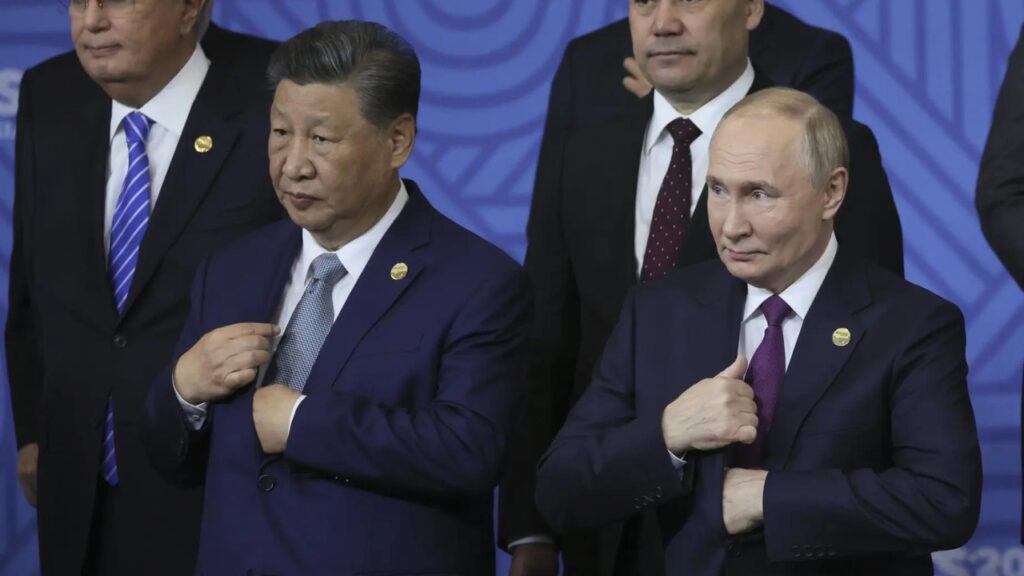The joint declaration issued by the Russian President Vladimir Putin and the Chinese President Xi Jinping on the eve of the Victory Day on May 9 upholding longstanding friendship to pursue mutual benefit and win-win outcomes in the new era carries major significance in the present period of global tariff war as also continuation of the war in Ukraine which is still unresolved despite efforts for truce in recent weeks.
President Xi Jinping is on state visit to Russia for four days beginning on May 7. He is the only big power attending the Victory Day celebrations organized by the Russian government to commemorate the surrender of the Germans and the end of fascist war in Europe. The other country heads including the UK, France and the USA are not attending. President Trump initially indicated his intention of attending the May 9 programme in Moscow, but he later changed his decision at the persuasion of the Pentagon and the strong opposition from the European nations to a visit which could boost the image of the Russian President Putin.
The joint declaration is a signal to the US President Trump that both China and Russia are united in their stand against the West and Trump’s efforts to make a deal with any one country of the two and use it as a counter to the other, will not succeed. Russia which is isolated in Europe has got full support of China in Putin’s bid to end the war. And similarly, China also is getting the support of Putin in President Xi’s protracted battle against Trump on the tariff rates. During the visit, twenty bilateral cooperation agreements between the two countries were signed. Both the Russian side and the Chinese officials said that the joint statement vindicated the deepening comprehensive strategic partnership between the two countries to meet the present geopolitical challenges.
Seasoned political analysts in Moscow have noted that President Putin has projected this year the Victory celebrations on May 9 in the backdrop of the sacrifices made by the Soviet people and the Communist Party which led the battle against the German fascists. Many separate programmes and events have been organized portraying the sacrifices and heroism of the old communist leaders. The Russian communist party sources term this as the opportunism of President Putin to play on the sentiments of the Russian people about the victory against the Germans fascists.
President Putin was elected as the President for the fifth time in March 2024 elections by getting 88.4 per cent votes. The Communist Party candidate NikolayKharitonov got only 4.37 per cent of the votes. The anti-Putin parties alleged than that the March elections were rigged which was confirmed by the International observers. Now after three years of the starting of Ukraine war and 14 months after his election as the fifth president, President Putin is getting the benefit of Russian nationalism. The communists are also supporting President Putin on the Ukraine war issue though they have reservations about many other policies including his authoritarian governance.
As regards President Xi Jinping, he is in complete command of the Chinese nation and the Chinese Communist Party. His main focus is on economic growth and expansion of the markets. Russia is a very big expanding market for the Chinese goods. In 2024, the bilateral trade reached nearly $250 billion, setting a new record. The two sides are also seeing strong momentum of cooperation in emerging sectors such as technological innovation, automobile manufacturing, cross-border e-commerce, and medical devices. People-to-people and cultural exchanges, such as the co-produced film Red Silk, the joint talent training program between top universities, and the joint science and education center initiative, are deepening the friendship between the peoples of both nations. .
President Xi needs stable allies in his protracted battle with the President Trump on tariff rates the outcome of which is crucial for the growth of China and in achieving its objective of outpacing the American economy’s GDP in 2049.The China-US trade talks have just started in Geneva on May 9 and it will continue till May 12. This is the first official high level meeting on trade after Trump announced his unilateral tariff rates on April 2 this year. Much of President Xi Jinping’s future economic programmes depends on the outcome of the US-China trade talks.
The United States has raised tariffs on Chinese imports to 145 percent, with cumulative duties on some goods reaching a staggering 245 percent .China has also been hit with sector-specific tariffs on steel, aluminium and car imports. Sales of Chinese goods to the United States last year totalled more than $500 billion — 16.4 percent of the country’s exports, according to Beijing’s customs data.
Beijing has vowed to fight the measures “to the end” and has unveiled reciprocal tariffs of up to 125 percent on imports of American goods, which totalled $143.5 billion last year, according to Washington. China has filed complaints with the World Trade Organization (WTO), citing “bullying” tactics by the Trump administration. China has gone after the US companies scrapping orders for Boeing Planes and declaring many top US companies as unreliable entities.
Beijing has also restricted exports of rare earth elements — critical for making a wide range of products including semiconductors, medical technology and consumer electronics. Beijing has long drawn Trump’s ire with a trade surplus with the United States that reached $295.4 billion last year, according to the US Commerce Department’s Bureau of Economic Analysis.
As against this Chinese action, US duties threaten to harm China’s fragile post-Covid economic recovery as it struggles with a debt crisis in the property sector and persistently low consumption. The tariff war is already having an impact in the United States, with uncertainty triggering a manufacturing slump last month and officials blaming it for an unexpected economic contraction during the first three months of the year.
China has just released its economic data for the quarter of 2025. This quarter does not fully reflect the impact of the tariff war but some nervousness was evident. If the war continues without any substantial reduction in duties on Chinese goods imported by the USA, its impact will be felt in the second quarter April-June 2025 and beyond. Manufacturing output and investment recoded 5.9 per cent growth in January March 2025 period. This was on expected lines but this growth can not be retained in the next two quarters if there is no trade deal.
The head of the WTO warned in April that the US-China standoff could cut trade in goods between the two countries by 80 percent. Beijing announced interest rate cuts on Wednesday aimed at boosting consumption — a sign that the tariff war has started hitting the Chinese economy. Both Trump and Xi badly need a deal. President Xi needs allies in that protracted battle with Trump on tariff rates. President Putin can be a rusted friend for the time being in that long battle. The Moscow declaration was a testimony to that. (IPA Service)

 India strikes three Pak airbases in retaliation
India strikes three Pak airbases in retaliation 